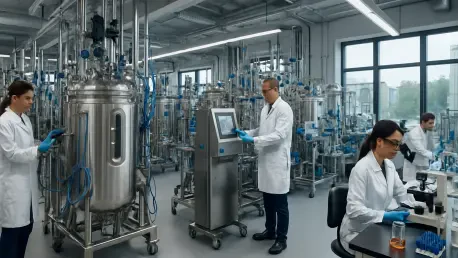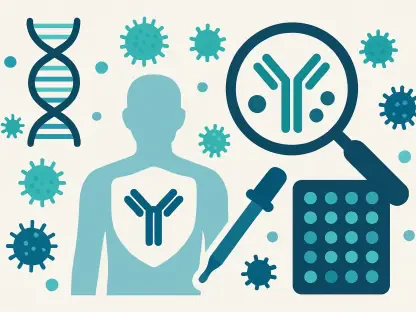In a groundbreaking move that has captured the attention of both the pharmaceutical industry and economic analysts, Eli Lilly and Co. has unveiled plans for a staggering $5 billion biomanufacturing facility in Goochland County, Virginia. Nestled in the West Creek Business Park, just a short distance from Richmond, this project ranks among the largest private capital investments in the state’s history. Far beyond a mere financial commitment, it signals a transformative shift for the region, positioning Virginia as a key player in the global biotech landscape. The facility aims to produce cutting-edge therapies for some of the most challenging health conditions, while also promising substantial economic benefits. This development raises compelling questions about the driving forces behind such a massive undertaking and its broader implications for healthcare and local communities. Delving into the details reveals a story of innovation, strategic planning, and a vision for the future of medicine in the United States.
Economic Powerhouse in the Making
The economic ramifications of Eli Lilly’s investment are nothing short of profound for Virginia. With a commitment of $5 billion, the project is set to generate over 650 permanent positions in specialized fields such as advanced manufacturing and scientific research. Additionally, around 1,800 temporary construction jobs will emerge during the development phase, injecting vitality into the local workforce. Governor Glenn Youngkin has hailed this as a “generational investment,” a term that underscores the long-term benefits anticipated for the region. The state has backed this initiative with significant financial incentives, potentially allocating up to $130 million through legislative approval, demonstrating the high stakes and competitive nature of securing such a transformative project. This influx of employment and capital is poised to stimulate growth in Goochland County and beyond, creating a ripple effect that could reshape the economic fabric of the area for decades to come.
Beyond job creation, the broader economic impact of this facility extends to positioning Virginia as a magnet for further industrial investments. The presence of a major pharmaceutical player like Lilly can act as a catalyst, drawing other biotech and manufacturing firms to the state due to the established infrastructure and skilled labor pool. This clustering effect often leads to innovation hubs where collaboration and competition drive progress. Local businesses, from suppliers to service providers, stand to benefit from increased demand, fostering a robust economic ecosystem. Moreover, the state’s investment in this project reflects a strategic focus on high-growth sectors, ensuring that Virginia remains competitive on a national and global scale. The economic narrative here is not just about immediate gains but about laying the groundwork for sustained prosperity, making this development a cornerstone of regional economic planning and a model for how targeted investments can yield widespread benefits.
Cutting-Edge Technology on Display
At the heart of this ambitious project lies a commitment to technological innovation that sets it apart in the pharmaceutical sector. The Goochland facility will serve as Eli Lilly’s first fully integrated site dedicated to producing antibody-drug conjugates (ADCs), therapies known for their complexity due to the handling of cytotoxic materials and the precision required in conjugation processes. To meet these challenges, the company plans to deploy advanced automation, machine learning, and digital systems to enhance production efficiency and accuracy. These technologies are not just about meeting current needs but are designed to future-proof the facility against evolving industry demands. With a focus on critical areas like oncology and immunology, as well as GLP-1 drugs for diabetes and weight management, this site aims to push the boundaries of what’s possible in drug manufacturing, setting a new standard for the industry.
The technological advancements planned for the facility also include modular production suites and state-of-the-art cleanroom designs, which offer flexibility to adapt to new therapeutic pipelines. This adaptability is crucial in an industry where innovation moves at a rapid pace, and the ability to pivot to emerging treatments can be a competitive edge. By integrating such forward-thinking infrastructure, Lilly is not only addressing the immediate demand for complex biologics but also preparing for the next wave of medical breakthroughs. The emphasis on digital integration further ensures real-time monitoring and optimization of processes, reducing errors and enhancing safety in handling sensitive materials. This technological blueprint reflects a broader trend in pharmaceutical manufacturing toward smarter, more agile operations, positioning the Virginia facility as a flagship for innovation and a testament to how technology can revolutionize healthcare delivery on a global scale.
Location as a Strategic Advantage
The choice of West Creek Business Park in Goochland County for this monumental project was no accident, as its strategic location offers unparalleled advantages. Situated along Route 288 with direct access to major thoroughfares like Interstates 64 and 95, the site ensures seamless connectivity for logistics and supply chain operations. Proximity to Richmond International Airport and the Port of Richmond further enhances its appeal, facilitating the efficient transport of materials and finished products. Certified by Dominion Energy Virginia for its favorable geological conditions and ready access to utilities, the park required minimal groundwork, making it an ideal, shovel-ready location. This strategic positioning not only supports the operational needs of a high-tech biomanufacturing facility but also underscores the meticulous planning that went into site selection for such a significant investment.
Infrastructure readiness played an equally critical role in sealing the deal for this location. State and local partners have worked diligently to prepare the site, with efforts including sewer and waterline extensions, new road construction, and utility expansions by entities like Columbia Gas of Virginia. These coordinated initiatives reflect a commitment to supporting large-scale industrial projects through robust infrastructure development. The logistical benefits extend beyond mere convenience, as they translate into cost efficiencies and faster turnaround times for production and distribution. The synergy of location and infrastructure at West Creek Business Park exemplifies how strategic planning can create an environment conducive to industrial success. This alignment of geographical and operational strengths ensures that Lilly’s facility is well-positioned to meet both current and future demands, reinforcing Virginia’s reputation as a prime destination for cutting-edge manufacturing ventures.
Aligning with National Manufacturing Goals
This investment arrives at a pivotal moment for the U.S. pharmaceutical industry, reflecting a broader push toward strengthening domestic manufacturing capabilities. Amid ongoing trade tensions and the looming possibility of tariffs on imported drugs, companies like Lilly are increasingly prioritizing local production to secure supply chains and mitigate risks. Federal voices, including Senator Tim Kaine, have emphasized the importance of bolstering the nation’s capacity to produce lifesaving medications domestically. This Virginia facility, part of a larger $18 billion commitment by Lilly to expand manufacturing sites worldwide, represents a strategic alignment with national goals to enhance self-reliance. The trend underscores a shift in industry priorities, where geopolitical considerations and market demands converge to drive significant investments in homegrown production infrastructure.
The focus on domestic manufacturing also carries implications for innovation and economic stability at a national level. By establishing advanced facilities on American soil, Lilly contributes to a resilient pharmaceutical ecosystem capable of responding to public health crises without dependence on foreign supply lines. This move aligns with policy initiatives aimed at incentivizing local production through tax benefits and grants, reflecting a collaborative effort between industry and government to fortify critical sectors. Furthermore, the concentration of such high-tech manufacturing in the U.S. fosters knowledge transfer and skill development within the workforce, creating a virtuous cycle of innovation and expertise. As global uncertainties persist, investments like this one in Virginia serve as a blueprint for how strategic corporate decisions can support national interests, ensuring that the country remains at the forefront of medical advancements while safeguarding access to essential therapies.
Shaping Virginia’s Biotech Landscape
Reflecting on the journey to this point, the establishment of Eli Lilly’s facility in Goochland County marked a historic milestone for Virginia’s biotech ambitions. State leaders, alongside local officials like Goochland County Board Chairman Tom Winfree, championed the project as a defining moment that elevated the region’s profile in the global biotech arena. The state’s robust workforce, top-tier educational institutions, and attractive incentive programs proved instrumental in securing this investment, setting a precedent for how strategic assets can lure industry giants. The successful collaboration between public and private entities during the planning and early implementation phases demonstrated a model of partnership that other regions might emulate, highlighting Virginia’s readiness to host transformative projects of this scale.
Looking ahead, the impact of this development offers actionable pathways for sustained growth in Virginia’s biotech sector. Policymakers and industry stakeholders should capitalize on this momentum by fostering additional partnerships and investments to build a thriving innovation hub. Initiatives to further enhance workforce training in advanced manufacturing and scientific fields will ensure a steady pipeline of talent to support future expansions. Additionally, leveraging this facility as a case study, the state can market itself aggressively to other biotech firms, showcasing the logistical and economic advantages that made this project viable. By continuing to prioritize infrastructure development and competitive incentives, Virginia can solidify its standing as a leader in high-tech industries, ensuring that the ripple effects of Lilly’s investment pave the way for a new era of opportunity and advancement in the region.









